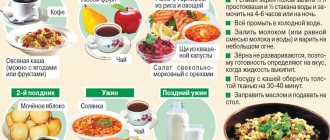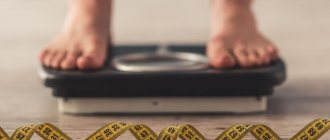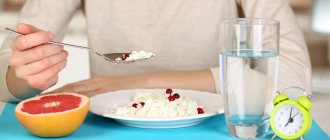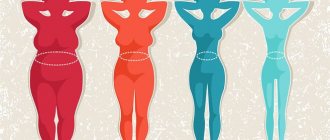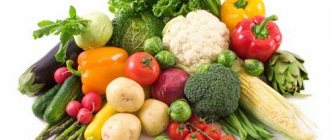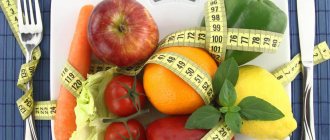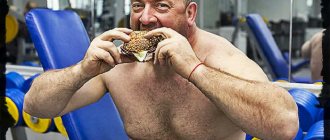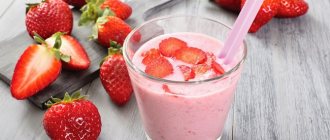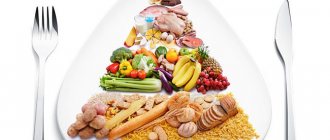Reads: 777
Reading time: 8 min.
no comments
Many women watch their diet to have a slim figure and feel good. Vegetarianism, separate meals and varied diets are in trend today, but few people know what a balanced diet is. In order not to gain excess weight and not have health problems, it is not at all necessary to limit yourself, give up your favorite foods and dishes, or eat something tasteless.
Learn all about a balanced diet and see that sticking to it is not so difficult.
The Basics of a Healthy Diet
You need to eat 5-6 times a day in small portions. The main meals are breakfast, lunch and dinner, and an additional 2-3 snacks. The menu must include natural products: fruits, vegetables, honey, fish, legumes, etc. These products contribute to the proper functioning of all organs, and also form a supply of nutrients and vitamins.
The basis of a balanced diet is regular and timely meals.
You should give up bad habits, and also exclude processed foods, fatty and spicy foods, carbonated drinks from your diet, and minimize the consumption of salt, sugar and spices.
Basic principles of a balanced diet
There are many principles with which you can balance your diet. The main ones should be considered.
- You should eat food in small portions and often.
- 20 minutes before your intended meal, you should drink 1 glass of clean water.
- It is not recommended to drink food with food, as this negatively affects the process of digesting food.
- Fatty and fried foods should be excluded from the diet.
- Replace alcoholic drinks with natural juices and purified water.
- You need to eat food at the same time every day, without skipping meals.
- You should avoid snacking on the go.
- It is necessary to perform daily exercises, which will help enhance the effect of a healthy diet.
Knowing what a balanced diet is and its principles, you can develop your own menu for every day.
Energy consumption
Determining energy consumption in each individual case has its own nuances. The energy expended must be compensated by the calories that enter the body with food.
Athletes or those involved in heavy physical work require 4 thousand kcal per day. For those who engage in mental work, this amount is 2.5 thousand kcal. With a decrease in physical activity, calorie consumption decreases sharply.
Age also affects energy expenditure. The older a person is, the fewer calories his body uses. After crossing the milestone of 50 years, the body reduces energy expenditure by 6% every 10 years.
Men's metabolism is 5-10% faster than women's. To replenish energy expenditure, they need to take in more food.
How to balance your diet
If you are wondering how to properly balance your diet, start with simple principles that you need to turn into habits:
- Don't overeat - finish the meal feeling slightly short of food. The feeling of absolute satiety will overtake you within half an hour after eating.
- Eat varied and tasty food, set the table beautifully. Switching to a balanced diet should not cause you negative emotions.
- Do not drink a lot of liquid after meals and during meals. It is better to drink a glass of water 20-30 minutes before meals.
- Pay attention to your meal schedule, eat little but often. Try to eat at the same time every day.
- Don't count calories. Just try to eat more low-calorie foods and eliminate high-calorie foods (sweets, fried foods, etc.).
- Try not to watch TV or be distracted by social networks while eating.
- Don't eat for two hours before playing sports or other physical activity and for an hour after.
- If you cannot get the required amount of vitamins from food (for example, in winter), buy vitamins at the pharmacy.
- Give up the habit of eating dishes or products when you have doubts about their quality. Don't eat food past its expiration date, even if it looks and smells "ok."
Perhaps now many of you were surprised to note that you already follow the principles of a healthy diet. All that remains is to slightly adjust your eating behavior and think through your diet.
How to balance your diet. Formula SP
Many people wonder how to balance their diet in order to get the most nutrients from food.
Fats are among the most energy-intensive substances. They contain fatty acids, phospholipids and vitamins. There are animal fats and vegetable fats.
Proteins play the role of foundation. They take part in the synthesis of vitamins, hormones and enzymes.
Carbohydrates are the fuel material that supports all essential functions. Carbohydrates include fiber, which helps digest food.
Vitamins and minerals help the body function properly.
The rules of the joint venture are simple. The volume of protein food entering the body per day is 15%. For every kilogram of a person's weight, there should be 1 g of protein.
The amount of fat entering the body should not exceed 30% of the daily diet. If we translate this into a percentage, we get the following picture:
- up to 10% – saturated acids;
- up to 15% – monounsaturated acids;
- up to 7% – polyunsaturated acids.
Saturated acids are present in large quantities in margarine and butter. Monounsaturated – in oils (corn, sunflower, soybean) and in fish. Polyunsaturated – in olive and peanut oils.
The amount of carbohydrates is 70% of all food consumed per day.
Fiber refers to carbohydrates that are not absorbed by the body. But without it, the normal functioning of the digestive system is disrupted. Foods containing fiber include:
- bread of different types;
- fruits;
- vegetables;
- potato;
- nuts;
- cereals
The joint venture formula will look like this:
DP = 80 g protein + 80 g fat + 400 g carbohydrates.
The daily menu option can be displayed in the table (breakfast, lunch, dinner and 2 snacks):
| Breakfast | The calorie content of breakfast should be no more than 40% of the daily value. |
| Lunch | Should not be more than 100 kcal (proteins, carbohydrates). The best option is cottage cheese with nuts. |
| Dinner | The amount of calories should be 30%. You should eat a hot first course, a side dish of vegetables combined with protein foods, and drink a glass of freshly squeezed juice. |
| Afternoon snack | You can snack on foods containing carbohydrates. Its calorie content should not exceed 150 kcal. It is recommended to drink green tea during the afternoon snack. |
| Dinner | The calorie content of the last meal is 20%. Food should contain vegetable proteins and carbohydrates. |
What is a balanced diet and how does nutritional balance work?
British Dietetic Association nutritionist Sian Porter says healthy eating isn't just about avoiding certain foods. On the contrary, it is an indicator of the correctness and frequency of consumption of necessary products in our daily diet.
Thus, a balanced diet is the enrichment of our menu with healthy foods necessary for life and maintaining optimal health, supporting all the energetic, physiological and psychological needs of our body. In practical terms, this means focusing our gastronomic preferences on a variety of products belonging to 5 groups in combinations that are beneficial to us.
5 food groups for a balanced diet
5 food groups for a balanced diet according to WHO recommendations
This infographic shows the WHO classification of food products, indicating the average number of daily servings a person needs to meet his needs.
The groups are divided based on similar nutrient composition and effects on our body. Thus, the first group, containing a large amount of starch, in addition to bread and grains, includes potatoes, despite the fact that they, by their kind, belong to vegetables. The fifth group includes oils combined with sweets, due to their high calorie content and the recommended low amount of consumption.
Thus, according to the recommendations, our daily plate should include grains (preferably whole grains) and protein (including beans and legumes), fruits, vegetables, low-fat dairy products, and a small amount of healthy fats.
How does nutritional balance work?
There are periods of life when we cannot or do not want to adhere to the above menu composition due to health problems or personal beliefs (for example, vegetarians do not eat meat). Refusal of important foods can lead to a lack of nutrients necessary for the functioning of the body. To prevent this from happening, we must compensate for their lack through alternative sources (they are also marked in the infographic), maintaining the desired balance. Let's say we decide to limit or eliminate meat from our diet. By doing this, we deprive ourselves of a good source of complete protein, vitamins (B, H, PP, A, E, D) and minerals (Na, K, Mg, Fe). In order to prevent their loss, it is necessary to replace it with other sources of protein (rice, beans, soy products), and also eat more vegetables, fruits, and fish.
The energy component of the food balance looks like this.
Factors influencing our energy balance and opportunities for achieving it.
Features of SP for women
Developing a balanced diet can be fun. Depending on a woman’s age, different foods should dominate her diet. The main principle of proper nutrition is to eat small portions, but often. The most acceptable option is 6 meals a day. The serving volume should not exceed 250 g.
Every day you need to drink 1.5 liters of pure still water. It is not recommended to eat immediately before bed. Dinner should occur 3 hours before going to bed.
Nutritionists recommend the following “evening” products:
- chicken meat;
- milk;
- porridge;
- mushrooms;
- celery;
- almond;
- apples.
According to recent studies, a high-calorie breakfast not only does not harm your health, but also helps in losing excess weight.
The most healthy and vitamin-rich foods are fruits and vegetables. They must be eaten 400 g per day for the proper functioning of all organs and systems.
Salt and sugar in large quantities are harmful to health. The permissible amount of sugar consumption is 50 g per day (12 tsp). The maximum amount of salt consumed per day is 5 g (1 tsp).
Features of SP for men
The balanced nutrition formula for men differs from that for women. The male body requires more calories, because it expends more energy in terms of body weight.
On average, a man needs to drink up to 2 liters of water per day, depending on the individual characteristics of the body.
For heavy physical activity, you need to consume 3500 – 4000 kcal per day. In this case, it is necessary to introduce porridge, rye bread, hard cheese, fish, butter, legumes, etc. into the diet.
Optimal meal plan
Breakfast is the most important meal of the day and should not be skipped. The calorie content of breakfast should be 400 kcal.
The following products must be selected for the joint venture. The best option is porridge: buckwheat, corn, oatmeal. It is recommended to add berries, fruits, honey and nuts to it.
For lunch, vegetable dishes and side dishes of cereals and hard pasta would be appropriate. Fresh herbs and mushrooms are tasty and healthy.
It is best to have a light vegetable salad and protein foods for dinner. If you really want to eat before bed, you can snack on a small handful of almonds. It is rich in protein and magnesium, helps relax muscles and helps you fall asleep quickly.
Approximate menu for a week
A sample menu for the week would look like this:
- Breakfast dishes:
- porridge with honey or cottage cheese, juice from natural fruits;
- sandwich with low-fat cheese, tea, 1 large orange;
- nuts, casserole (cottage cheese), green tea;
- omelette, shortbread cookies, tea;
- pancakes with curd filling, coffee beans, tangerines.
- Lunch dishes:
- chicken broth with noodles, vegetable salad, baked turkey;
- mushroom soup, vegetable stew, fruit salad, juices;
- buckwheat soup, oatmeal, boiled beef, berry juice;
- vegetable soup, steamed fish, bread (without yeast), compotes;
- beans, boiled meat, vegetable salad, fruit.
- Dishes for dinner:
- seafood salad, cottage cheese casserole with carrots, compote;
- porridge, vegetable salad;
- boiled chicken fillet, Greek salad, green tea;
- vinaigrette seasoned with sunflower oil, baked fish, 100 g of cottage cheese;
- stewed vegetables, jelly.
Menu for the week, budget option
The weekly diet can be displayed in the following table:
| Monday | Z.: 100 g of oatmeal with the addition of 0.5 tsp. honey, applesauce. A: salad of tomatoes, cucumbers and radishes, seasoned with homemade yogurt, 150 g of baked fish. U.: 3 cheesecakes, dried fruit compote. |
| Tuesday | Z.: 1 cup of coffee without additives, a slice of dry bran bread with butter. A: 3 boiled potatoes, sprinkled with dill, dates, tea. U.: vegetable stew, 100 g of stewed cod. |
| Wednesday | Z.: Omelet with tomatoes and bell peppers. A: Brown rice, corn. U.: salad of Chinese cabbage, cucumbers and dill with olive oil. |
| Thursday | Z.: fruit salad with low-fat yogurt. A: broccoli soup, 2 fresh cucumbers, a slice of cheese. U.: cabbage salad with sour cream (15%), 80 g chicken meat. |
| Friday | Z.: black coffee, 1 boiled egg, Chinese cabbage salad. A: 2 boiled potatoes, 3 fresh cucumbers, cheese. U.: 100 g of buckwheat porridge and the same amount of grilled flounder. |
| Saturday | Z.: green tea (unsweetened), vegetable salad. A: 200 g turkey, baked with tomatoes and cheese. U.: 200 g of vegetable stew without salt and spices, carrots and apple in salad for dinner. |
| Sunday | Z.: tea, bread with jam, dried fruits. A: vegetable soup, green bean salad. U.: Noodles with cabbage, omelette. |
Sample menu for a week for losing weight
To lose weight, you need to eat a balanced diet and eat low-calorie foods.
| Reception food Day | Breakfast | Dinner | Dinner |
| Monday | 1 glass of fresh juice or water on an empty stomach, oatmeal with honey and nuts, rye bread. | Fish (steamed or stewed), tea without sugar, boiled potatoes. | Steamed vegetables (starch-free). |
| Tuesday | 100 g low-fat cottage cheese with dried fruits, tea, boiled egg. | Boiled veal, vegetable soup, juice. | Half an avocado, low-fat cottage cheese or kefir. |
| Wednesday | 2 grain breads with cheese, tea with lemon balm, ginger or mint. | 200 g boiled chicken fillet, steamed asparagus, orange juice. | Vegetable salad with rye bread. |
| Thursday | 2 grain breads, low-fat yogurt, juice. | 150 g boiled or baked red fish. | Boiled chicken breast with herbs. |
| Friday | Green tea, 3 slices of low-fat cheese, porridge with dry fruit. | Chicken broth, steamed vegetable sauté. | 150 g fish fillet or cottage cheese. |
| Saturday | 150 g boiled chicken fillet, tea, bread. | Vegetable salad with cheese, mint tea or fresh juice, bread, pasta with tomato paste, | Ryazhenka or drinking yoghurt (unsweetened). |
| Sunday | Porridge with fruit, apples, juice. | 150 g lean meat, steamed cauliflower or broccoli, still water. | Bean salad with red pepper. |
Approximate daily menu for a week to maintain weight at the same level
To keep yourself in good shape, you should do a set of exercises and diet every day. Sample menu:
| Reception food Day | Breakfast | Dinner | Dinner |
| Monday | Tea with cottage cheese and dried fruits. | Buckwheat with lean boiled meat, vegetable salad, whole grain bread. | 3 types of stewed vegetables (your choice). |
| Tuesday | Cheese, porridge with honey and fruit, herbal tea. | Meat broth, steamed fish, yeast-free bread. | Vegetable salad, boiled chicken fillet. |
| Wednesday | Omelet, toast, juice. | Spaghetti with sauce, mushroom soup. | Stewed meat, vinaigrette. |
| Thursday | Cottage cheese, porridge with fruit and milk, tea. | Lasagna, spinach cream soup. | Salmon baked in foil. |
| Friday | Tea, oatmeal with honey and nuts. | Chicken broth, boiled potatoes with herbs. | Sea food salad, bran bread. |
| Saturday | 2 toasts with lean cheese, juice. | Boiled meat with beans. | Vegetable salad with vegetable oil. |
| Sunday | Buckwheat with milk. | Vegetable soup, boiled meat, bread. | Carrot casserole, juice. |
Example of a daily diet
A balanced breakfast plays an important role in a complete diet. Approximate diet:
| Reception food Day | Breakfast | Dinner | Dinner |
| Monday | Millet porridge with raisins. | Lenten cabbage soup. | Salad of cucumbers and tomatoes with herbs and olive oil. |
| Tuesday | Banana smoothie. | Vermicelli soup with breadcrumbs and dill. | Zucchini stewed with pumpkin. |
| Wednesday | Pumpkin, corn porridge. | Spinach soup with beans and broccoli. | Grilled Brussels sprouts. |
| Thursday | Oatmeal with banana. | Buckwheat porridge, broccoli, soy cutlet. | Vegetable okroshka. |
| Friday | Barley porridge with berries. | Pickle with mushrooms. | Brown rice, vegetables, seaweed and seafood salad. |
| Saturday | Oatmeal pancakes. | Steamed cauliflower, red beans, mushrooms. | Vegetable stew. |
| Sunday | Semolina porridge and apple baked with cinnamon. | Pasta with tomatoes, mushrooms, herbs. | Mix of lettuce, tomatoes, green peas with olive oil, soy pate. |
How to eat balanced?
The principles of a healthy diet based on a balanced diet were formulated by WHO in 1991.
The word “balance” in translation means “equilibrium”. A balanced diet is one that meets a particular person’s need for nutrients (proteins, fats and carbohydrates), vitamins, microelements and electrolytes.
Each person's needs are different. A growing child needs a lot of carbohydrates and proteins to build organs, a pregnant woman needs proteins and fat, and fewer carbohydrates, an infectious patient needs plant and animal proteins to form an immune response, vitamins, microelements and water to neutralize toxins. The old man needs dairy and vegetable products, which contain little protein, but contain fiber, microelements and easily digestible fat.
Therefore, general recommendations for a balanced diet are the same as the average temperature in a hospital.
To create an individual balanced diet, you need to know the following parameters:
- age;
- floor;
- body mass;
- daily calorie requirement;
- Lifestyle;
- physiological state (pregnancy, illness, recovery).
Basic principles of a balanced diet
The World Health Organization believes that a person should have certain goals to build a healthy diet:
- The basic ratio of essential nutrients is: carbohydrates 50%, proteins 30%, fats 20%. This ratio is calculated for a healthy middle-aged person. When drawing up a real diet, you need to take into account specific needs: for an athlete to increase the amount of carbohydrates, for a child - for proteins, for a convalescent - for easily digestible fat.
- The total amount of fat should not exceed 30%, with only 10% being saturated animal fats (lard, butter), the rest being vegetable. Reducing animal fats in favor of plant fats reduces the risk of cardiovascular disease, prostate and colon cancer, hypertension and obesity.
- It is recommended to consume dark green fruits and vegetables at least 4 times daily. This also includes whole grain products and legumes (beans, soybeans, peas). Plant foods provide the body with complex carbohydrates, fiber, minerals and vitamins. In countries where plant foods predominate, there is practically no atherosclerosis, oncological tumors of the digestive canal and lungs.
- An increase in protein in the diet relative to the physiological norm does not lead to any positive changes in the structure of diseases. It is better to “get” the missing calories with plant foods.
- The main condition for a balanced diet is maintaining a balance between calorie intake and expenditure. Excess calories lead to obesity, and decreases lead to exhaustion and dystrophy.
- To calculate normal weight, the body mass index is used (weight must be divided by height squared). Normal BMI is from 18.5 to 25, below ─ underweight, from 25 to 30 overweight, above 30 ─ obesity. BMI is calculated for persons over 18 years of age.
- When cooking, you need to use a minimum of oil or choose cooking methods that do not use oil - baking, steaming, stewing in water. Adding oil doubles the calorie content of the dish. The same applies to sugar. So, if an apple has a calorie content of 80 kcal, then baked with sugar is 100 kcal, and a slice of apple pie is 330 kcal.
- The amount of table salt per day is 6 grams or one heaped teaspoon. This includes all the salt eaten during the day ─ in bread, marinades, sauces, etc. An increase in the amount of salt clearly leads to the formation of hypertension or high blood pressure.
- To maintain normal calcium levels, you need to consume dairy products and fresh greens daily. This is especially important for children, adolescents and pregnant women. The calcium reserve created in adulthood prevents the formation of osteoporosis (bone loss, dangerous for fractures) in old age.
- WHO warns against recklessly increased use of pharmaceutical vitamin-mineral complexes, since any tablet or dragee of any product from this group contains a daily dose of vitamins and minerals. Excess vitamins overload the kidneys and disrupt the metabolism of other substances. The best way is to consume fresh vegetables and fruits.
"Good" and "Bad" Foods by Nutrient Diversity
There are no absolutely “bad” and absolutely “good” products; we are talking about the benefits for a specific person.
Normal foods (not fast food) contain all the necessary substances, but in different quantities. Close to complete (contain a full range of substances, you can eat one type without harm to health) are:
- buckwheat;
- milk and fermented milk products;
- river and sea fish;
- legumes (especially chickpeas);
- eggs;
- nuts, especially walnuts.
Sample menu for the week
| Breakfast | Dinner | Dinner | |
| Monday | Vegetable salad with rice, boiled egg, tea without sugar | Fish soup, boiled fish, slice of bread, compote | Boiled chicken slice, vegetable salad, rose hip decoction |
| Tuesday | Buckwheat porridge with milk, weak coffee with milk | Chicken soup, steam cutlet, vegetable salad, tea | Galette cookies with kefir |
| Wednesday | Oatmeal with milk, cottage cheese and honey | Vegetarian borscht, baked fish, fruit juice | A piece of boiled beef with cauliflower, jelly |
| Thursday | Omelet, strong tea | Vegetable soup, boiled beef, compote | Cottage cheese with honey, herbal tea |
| Friday | Fish cutlet, vegetable salad, coffee | Meat borscht, vegetable casserole, fruit drink | Dumplings with cottage cheese, kefir |
| Saturday | Meatballs, millet porridge, tea | Beef broth soup, boiled beef, vegetable salad, compote | Cottage cheese casserole with fruit, herbal tea with honey |
| Sunday | Stewed vegetables with fish, tea, bread | Meat borscht, steam cutlets, salad, compote | Cottage cheese with fruit, jelly |
As an afternoon snack or second breakfast, you can use an apple, a glass of low-fat kefir, a piece of dark chocolate, boiled beets or corn, and fresh herbs.
Balanced menu for the week
You can create your own menu for each day. It is recommended to consult a nutritionist about drawing up a joint venture menu for different periods.
Menu for children
SB for children must contain all the substances necessary for growth and development: fruits, vegetables, berries, meat, fish, grains and legumes. It is not recommended to give children store-bought sweets, chips, corn sticks, carbonated drinks, etc.
The daily requirement of a child’s body for vitamins and microelements is expressed in the table.
| 3 years | 4-6 years | 7 years | |
| Energy value, kcal | 1540 | 1970 | 2350 |
| Proteins, g | 53 | 68 | 77 |
| Fats, g | 53 | 68 | 79 |
| Carbohydrates, g | 212 | 272 | 335 |
Menu for women
There are various formulas for individual calculation of the required number of calories per day. They take into account a person’s personal parameters. For a woman, the daily calorie intake is 1800-2000.
To create a weekly menu for a woman, you should consult a nutritionist who will take into account the individual characteristics of the body: age, health status, metabolism, etc.
To maintain healthy functioning of the body, it is necessary to consume the following elements:
• amino acids (animal proteins – meat, milk, eggs);
• Omega-3 unsaturated fatty acids (spinach, fish, flaxseed oil);
• long carbohydrates (oatmeal, buckwheat, legumes, rice).
You should not suddenly switch to a new diet, because this is not a rigid diet, and radical measures will be unnecessary. The calorie content of foods should be reduced slowly so as not to put the body into a stressful state. Food should bring not only benefits, but also pleasure.
Menu for men
For an office worker who is not overweight, who does not go to the gym, but spends time actively on weekends, the daily norm will be 3000 kcal.
Approximate men's menu for 1 day:
1. Breakfast: scrambled eggs with bacon or chicken sausage salad with boiled eggs and fresh cucumber, seasoned with sour cream (fat content no more than 15%). You can drink a cup of black (green) tea or coffee with milk (cream should be excluded from the diet). Toast with honey (jam) or a black bread sandwich with caviar or salmon will go well with tea.
2. Lunch: meat broth with vegetables or chicken noodle soup. For the second course - puree with boiled lean meat (the best option is 200 g of chicken fillet). Tea with a sandwich or toast.
3. Dinner: vegetable stew or stewed cabbage with meat. You can replace them with 3 pancakes with meat filling. 2 hours before going to bed, you should eat low-fat cottage cheese, and before going to bed, drink 1 glass of kefir or yogurt.
Between main meals, you can have snacks (if necessary), during which it is recommended to eat a fruit or vegetable salad and a sandwich with tea.
Menu for the whole family
Creating a menu for a family is not an easy task, since it is necessary to take into account the needs and individual characteristics of each member. Before starting to create a menu, you should consult a nutritionist.
Menu for schoolchildren
When entering school, the load on the body, in particular on the brain and nervous system, increases many times over. Children definitely need to have breakfast. For breakfast, it is good to eat muesli or chocolate balls with milk. You must take cheese sandwiches, fruit, and water with you to school. First courses are the basis of the diet for a growing body. There should be light snacks between main meals.
For athletes
The sports menu is selected depending on the level of stress, type of sport, and physical characteristics of the athlete. His diet should contain 30% proteins, 10% fats, 60% carbohydrates. Products for sporty people:
- poultry meat;
- cottage cheese;
- eggs;
- oil;
- nuts;
- bread;
- cereal porridges;
- fruits and vegetables.
For the vegan bodybuilder
The nutritional program of a vegan bodybuilder can be varied. The most suitable products for this lifestyle:
- soy;
- Soy meat;
- tofu;
- chickpeas;
- lentils;
- peas;
- seitan;
- nuts, cereals, legumes, fruits;
- rice (red, brown, black);
- buckwheat;
- durum pasta;
- oat groats;
- dates, raisins, prunes, dried apricots;
- avocado;
- citrus;
- rose hip.
Recommendations for proper healthy eating
First of all, the diet should include the required amount of liquid - 2.5-3 liters per day. Preferably it should be water and other non-alcoholic drinks low in calories and sugar (tea, coffee).- Proper nutrition for health is impossible without a sufficient amount of vegetables (at least 400 grams for 2-3 or more servings per day). Fresh vegetables, including unheated raw vegetables, are an important source of vitamins, minerals, secondary plant matter and fiber.
- It is recommended to eat 2-3 eggs per day . Eggs are an excellent source of protein and omega-3 fatty acids (if the chickens graze in the meadow), as well as choline, it is recommended to consume 2-3 eggs per day.
- If you have a healthy diet, the menu should include fruit (at least 300 g per day). Fresh fruits, as well as dried fruits, are an excellent source of many vitamins, minerals, secondary plant substances and fiber. However, many people experience complaints when consuming large quantities of fruit sugar, so fruit should always be taken in small portions! Eat fruits as nature provides them, not in the form of juices - since in this case the fruit sugar is located outside the cellular structures, which must first be digested to release the sugar. In this case, you consume fruit sugar in high concentrations. The result is a high level of glycation of important proteins, including in the brain. But these advanced glycation end products (AGEs) interfere with normal functioning. Smoothies also contain a large amount of free sugar, as this destroys cellular structures.
- Cereals and potatoes must be included in a proper diet (about 2-3 meals a day). Essentially, grains are a source of carbohydrates as well as a source of proteins. To do this, you need to avoid grains with harmful effects. These include: - gluten content - the content of agglutinin from the wheat germ, which is found, in particular, in wheat, rye and barley. It is best to consume flour products, baked goods and muesli made from pseudo-cereals, such as buckwheat. The “pseudo-cereals” recommended as replacements for so-called gluten-containing grains are listed in the lists below. Cereals provide the body with complex carbohydrates, fiber and secondary plant substances, and are also an important source of vitamins (primarily B vitamins) and minerals (for example, iron, zinc, magnesium). Potatoes contain vitamin C, potassium and magnesium, among other things, and it is also recommended to eat Jerusalem artichoke or sweet potatoes.
- Healthy eating includes protein-rich, plant-based meals
(e.g. peas, beans, chickpeas, lentils) and other meat alternatives (50-150 grams of protein per day), legumes contain fiber, B vitamins, magnesium, potassium and iron, as well as secondary plant matter. - Nuts and seeds are also foods for proper nutrition (30-60 g per day). Nuts and seeds contain high quality natural fatty acids. Along with walnuts, flax seeds, hemp seeds and chia seeds are especially recommended. They contain high quality protein, folate, vitamin E, secondary plant matter and many minerals such as potassium, magnesium, iron and zinc, and especially healthy fatty acids. Flaxseed oil, for example, contains 50% of the important omega-3 fatty alpha-linolenic acid.
- If you choose proper nutrition, the menu should include vegetable fats (2-4 tablespoons per day). Important for the provision of natural fatty acids, as well as for the consumption of fat-soluble vitamins (A, D, E and K). It is recommended to consume natural vegetable oils rich in alpha-linolenic acid (mainly flaxseed and rapeseed oil). Since we are talking about oils with a high proportion of unsaturated fatty acids - high in omega-3 fatty acids, it must be taken into account that they have a short shelf life. Therefore, they should always be stored in dark glass bottles, always purchased in small portions, stored in the refrigerator and not placed in the sun.
- Lean red meat 1-2 times a week, white meat 1-2 times a week, fish (herring, salmon, trout, pike perch) 4-5 times a week as a source of high-quality protein.
- It is also important to know, for those who choose proper nutrition, foods that should be avoided : dry snacks, alcoholic beverages and sweets, wheat and rye products.
Specialized clinic
Doctor: Albert Eimiller. Gastroenterologist
Eimiller Gastroenterology Clinic
9.8/10
Germany, Munich
in Munich at the IZAR Medical Center
The Eimiller Gastroenterology Clinic is a department of gastroenterology headed by Dr. Albert Eimiller at the state-of-the-art medical center ISAR Klinikum, Munich.
Submit a requestDoctor's profile
